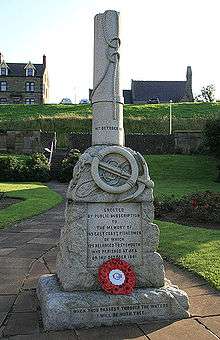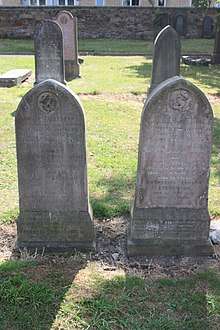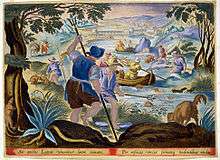Eyemouth disaster
The Eyemouth disaster was a severe European windstorm that struck the south-eastern coast of Scotland, United Kingdom, specifically Berwickshire, on 14 October 1881. One hundred and eighty-nine fishermen, most of whom were from the village of Eyemouth, were drowned. Many citizens of Eyemouth call the day Black Friday.


Casualties
Some boats that had not capsized were wrecked on the Hurkar Rocks. Many houses were also destroyed. Two days later, the Ariel Gazelle turned up in Eyemouth, having braved the storm instead of fleeing.[2]
Aftermath

A donation-led relief fund was established to provide financial security to families who had lost members to the storm. The response was significant, bringing in over £50,000 (£4,550,000 in 2015).[3][4]
The disaster was the subject of a contemporary oil on canvas painting by Scottish artist J. Michael Brown
See also
Notes
- Edinburgh Evening News Oct15,1881
- "Historical Prints: Ariel Gazelle". Eyemouth Museum. Retrieved 18 February 2018.
- UK Retail Price Index inflation figures are based on data from Clark, Gregory (2017). "The Annual RPI and Average Earnings for Britain, 1209 to Present (New Series)". MeasuringWorth. Retrieved 2 February 2020.
- New Research Paper 2005 template Archived 26 March 2009 at the Wayback Machine
References
- Peter Aitchison. Children of the Sea: The Story of the People of Eyemouth. Tuckwell Press Ltd, 2001.
Further reading
- "Black Friday" by Peter Aitchison {Birlinn Press, 2006}
- "The Boy Who Came Ashore" by Alan Gay (Dreadful Night Press, 2006)


